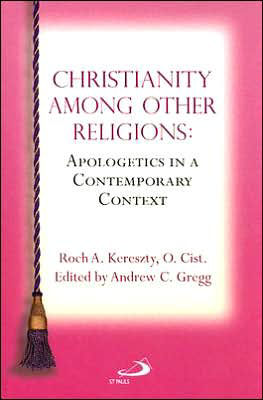
|
Posted January 17, 2007
Book: Christianity Among Other Religions: Apologetics in a Contemporary Context Author: Roch A. Kereszty, O. Cist. Edited by Andrew C. Gregg Society of St. Paul. Staten Island, NY. 2006. Pp. 226 An Excerpt from the Jacket:
An Excerpt from the Book: 1. Muhammad, the Seal of the Prophets The chief source for our reconstruction of the life, deeds, sayings, and personality of Muhammad is the Hadith (literally, statement), a large body of literature that began to be put into writing two hundred years after the death of the Prophet. Even Islamic scholars question the authenticity of certain Hadith collections, while they accept others that, although formulated late in time, reflect what these scholars perceive as the authentic spirit of Islam. Muhammad was born from the Arab clan Quraish around 570 A.D. in Mecca. He came from a family that practiced monotheism, the legacy of Abraham. According to Islamic sources, his family derived itself from Ishmael, the son of Abraham. His father died before Muhammad was born, his mother, when the child was six, so Muhammad was raised first by his grandfather, then by his uncle. As a young man, he was employed by a wealthy widow named Khadijah. He acted for her as the overseer of her caravan of camels on journeys to Syria. He gained her full trust, and at the age of forty Khadijah became Muhammad’s wife. Muhammad was deeply religious from a young age and spent considerable time in prayer and meditation in the hills of the countryside. One night around the year 610 (now commemorated on the 27th of the month of Ramadan) he had a troubling visitation: the angel Gabriel commanded him to recite God’s message (“qur’an” means recitation). Muhammad was deeply shaken and sought counsel and reassurance from Khadijah, who became the first believer in the authenticity of her husband’s prophetic mission. The second visitation came a year later, after which the messages, and sometimes visions, became more frequent. Muhammad believed that his mission, received from Allah through the mediation of the angel Gabriel, was to proclaim Allah to be the only God and, thus, to restore the primordial religion of Adam and Abraham. In this one authentic religion humankind must submit itself to its Creator in total obedience. In Mecca the majority of people were polytheists, who believed in many lesser gods and goddesses along with Allah, the chief god. Muhammad came from the ranks of the hanifs, who believed only in the one God Allah, but Christians and Jews also lived in the area of Mecca. Muhammad could not read or write, so, barring direct revelations from God, his only way to learn of Jewish and Christian traditions had to come through oral traditions from local Jews and Christians. In Mecca, Muhammad’s initial proclamation did not meet with great success. The city made its living from the pilgrims who came to worship its 360 idols of the many different gods and goddesses, and the merchants were afraid that, if Muhammad’s religion should spread among the people, they would lose all their income. The hostility against the Prophet grew so strong that he and his adherents migrated to Yathrib about 300 miles to the north, a city that later became known as Medina, “the city of the Prophet.” In Yathrib the Prophet was received favorably and soon became the city’s sole religious and political leader. The year of Muhammad’s flight or migration (Hijra), 622 A.D., became the first year of the Islamic calendar. Its importance for Muslims derives from its being the year of the foundation of the first Islamic society. In Medina Muhammad prohibited the worship of all gods but Allah, established set times for daily public prayer, and set Friday as the day of the main weekly religious service. Meanwhile the violent skirmishes between the people of Mecca and the Muslims of Medina escalated until Muhammad finally decided to return to Mecca with a large army in 630. The city surrendered to him and Muhammad had all the idols of the gods and goddesses smashed. He transformed Mecca into an Islamic city according to the pattern followed in Medina. Nevertheless, he preserved the Ka’bah (“cube”), a large cubic stone structure that contains the Black Stone, and made it into the center of piligrimage for all Muslims. All the images of pagan gods and goddesses were painted over, but according to Islamic tradition the Prophet did not allow the image of the Virgin Mary with her Child to be eliminated. In 632, the year he died, Muhammad led the first pilgrimage to the Ka’bah. Table of Contents: Part I: A philosophical approach to reality and its meaning Part II: A survey of world religions Part III: Christianity, the sacramental presence of God’s saving love in history Part IV. The Christian view on the relationship between Christianity and other religions Reader’s Guide Part I: A philosophical approach to reality Part II: A survey of world religions Part III: Christianity, the sacramental presence of God’s saving love in history Part IV: The Christian view on the relationship between Christianity and other religions Appendix: The meaning and function of Logos in Justin’s “Christian Philosophy” |
|
